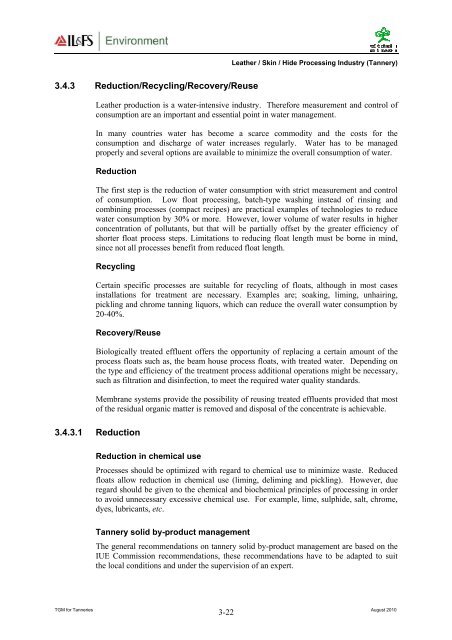Leather/Skin/Hide Processing Industry - Environmental Clearance
Leather/Skin/Hide Processing Industry - Environmental Clearance
Leather/Skin/Hide Processing Industry - Environmental Clearance
You also want an ePaper? Increase the reach of your titles
YUMPU automatically turns print PDFs into web optimized ePapers that Google loves.
<strong>Leather</strong> / <strong>Skin</strong> / <strong>Hide</strong> <strong>Processing</strong> <strong>Industry</strong> (Tannery)3.4.3 Reduction/Recycling/Recovery/Reuse<strong>Leather</strong> production is a water-intensive industry. Therefore measurement and control ofconsumption are an important and essential point in water management.In many countries water has become a scarce commodity and the costs for theconsumption and discharge of water increases regularly. Water has to be managedproperly and several options are available to minimize the overall consumption of water.ReductionThe first step is the reduction of water consumption with strict measurement and controlof consumption. Low float processing, batch-type washing instead of rinsing andcombining processes (compact recipes) are practical examples of technologies to reducewater consumption by 30% or more. However, lower volume of water results in higherconcentration of pollutants, but that will be partially offset by the greater efficiency ofshorter float process steps. Limitations to reducing float length must be borne in mind,since not all processes benefit from reduced float length.RecyclingCertain specific processes are suitable for recycling of floats, although in most casesinstallations for treatment are necessary. Examples are; soaking, liming, unhairing,pickling and chrome tanning liquors, which can reduce the overall water consumption by20-40%.Recovery/ReuseBiologically treated effluent offers the opportunity of replacing a certain amount of theprocess floats such as, the beam house process floats, with treated water. Depending onthe type and efficiency of the treatment process additional operations might be necessary,such as filtration and disinfection, to meet the required water quality standards.Membrane systems provide the possibility of reusing treated effluents provided that mostof the residual organic matter is removed and disposal of the concentrate is achievable.3.4.3.1 ReductionReduction in chemical useProcesses should be optimized with regard to chemical use to minimize waste. Reducedfloats allow reduction in chemical use (liming, deliming and pickling). However, dueregard should be given to the chemical and biochemical principles of processing in orderto avoid unnecessary excessive chemical use. For example, lime, sulphide, salt, chrome,dyes, lubricants, etc.Tannery solid by-product managementThe general recommendations on tannery solid by-product management are based on theIUE Commission recommendations, these recommendations have to be adapted to suitthe local conditions and under the supervision of an expert.TGM for Tanneries August 20103-22
















